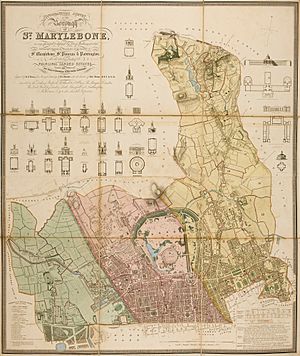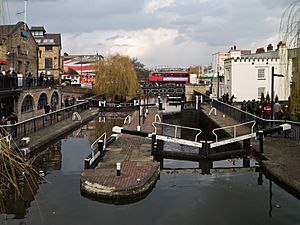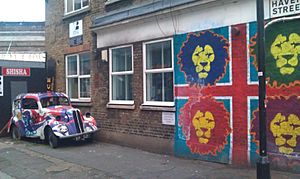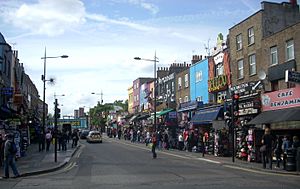Camden Town facts for kids
Quick facts for kids Camden Town |
|
|---|---|
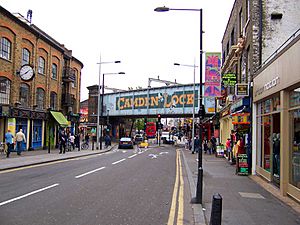 Camden High Street, near where it becomes Chalk Farm Road (facing towards Chalk Farm) |
|
| Population | 24,538 (Camden Town with Primrose Hill and Cantelowes wards, 2011) |
| OS grid reference | TQ295845 |
| • Charing Cross | 2.5 mi (4.0 km) SSE |
| London borough | |
| Ceremonial county | Greater London |
| Region | |
| Country | England |
| Sovereign state | United Kingdom |
| Post town | LONDON |
| Postcode district | NW1, NW5 |
| Dialling code | 020 (London) |
| Police | Metropolitan |
| Fire | London |
| Ambulance | London |
| EU Parliament | London |
| UK Parliament |
|
| London Assembly |
|
Camden Town (![]() i/ˈkæmdən/), often called Camden, is a lively area in London. It's about 4.1 kilometers (2.5 miles) north-northwest of Charing Cross, a central point in London. Camden is known as one of the 34 main centers in Greater London.
i/ˈkæmdən/), often called Camden, is a lively area in London. It's about 4.1 kilometers (2.5 miles) north-northwest of Charing Cross, a central point in London. Camden is known as one of the 34 main centers in Greater London.
This area started as a residential neighborhood in 1791. It was once part of Kentish Town and the parish of St Pancras. Camden Town became very important when railways were first built, which also connected it to London's canal system. Today, instead of factories, Camden is famous for its shops, tourism, and fun entertainment. It's especially known for its street markets and music places that celebrate alternative culture.
Contents
History
How Camden Got Its Name
Camden Town is named after Charles Pratt, 1st Earl Camden. His title, "Earl Camden," came from his estate called Camden Place. This estate was near Chislehurst in Kent. The name "Camden" was also used for a group of artists in the early 1900s called the Camden Town Group. Later, in 1965, the whole area became the London Borough of Camden.
How Camden Grew
In the 1800s, during the Industrial Revolution, Camden became a key railway stop. The North Western Railway ended here in 1837. Goods were moved from trains to London's roads using many horses. Places like the Roundhouse (built in 1846), Camden Lock, and the Stables were all part of this busy transport hub.
Camden Town was built on land that used to be the manor of Kentish Town. Sir Charles Pratt, a lawyer and politician, gained control of this land. In 1791, he began allowing houses to be built there. In 1816, the Regent's Canal was dug through the area. For a long time, Camden Town wasn't considered a very trendy place. However, the Camden Markets, which began in 1973, have grown hugely and now attract many visitors. In 2008, the Camden Canal market had a big fire, but no one was hurt. It later reopened as Camden Lock Village.
Governance
From 1900 to 1965, Camden Town was part of the Metropolitan Borough of St Pancras. In 1965, it became part of the new London Borough of Camden. Camden Town is the place the borough is named after and where its main offices are located.
Geography
Camden Town is on fairly flat land, about 30 meters (100 feet) above sea level. It's about 4 kilometers (2.5 miles) north-northwest of Charing Cross. To the north, you'll find the hills of Hampstead and Highgate. To the west is Primrose Hill. The River Fleet, which flows underground in pipes, starts on Hampstead Heath and goes through Camden Town on its way to the River Thames. The Regent's Canal also runs through the northern part of Camden Town.
 |
Chalk Farm and Belsize Park | Kentish Town | Holloway |  |
| Regent's Park | Islington | |||
| Fitzrovia | Somers Town | Kings Cross |
Economy
By the end of the 1900s, businesses related to entertainment started moving into Camden. A Holiday Inn hotel was built next to the canal. Many big chain stores and restaurants replaced smaller, independent shops because rents became too high. However, many restaurants with different types of food still do well, especially near the markets. You can find them on Camden High Street and its side streets like Parkway, Chalk Farm Road, and Bayham Street. In 2006, the historic Stables Market was expanded with a new steel and glass section, making it even bigger.
Camden Street Markets
Camden is super famous for its markets! Most of these markets started in 1974 or later. The Inverness Street market has been around for over a century, originally selling food. But by 2013, it mostly sold tourist items. The main Camden Lock Market began in 1973 in an old timber yard. Now, it's surrounded by five other markets: Buck Street market, Stables market, Camden Lock Village, and an indoor market in the Electric Ballroom.
These markets are a huge attraction, especially on weekends. They sell all sorts of things, like fashion, books, food, antiques, and unique, unusual items. Young people especially love them for finding "alternative" clothing. While they first opened only on Sundays, the markets are now open most days, but they are busiest on weekends.
Performance venues
- Electric Ballroom
- The Dublin Castle
- Dingwalls
- The Jazz Cafe
- Koko (music venue)
- Roundhouse (venue)
Transport
London Underground
Camden Town tube station is very close to the markets and other attractions. Chalk Farm and Mornington Crescent tube stations are also nearby. Camden Town station is a key stop for the Northern line, connecting to different parts of London.
When the station was built in 1907, the tracks had to go exactly under the narrow streets. This was to avoid paying landowners for space. Because of this, the station platforms are very narrow, with one platform directly above the other. There's even an old air raid shelter under the station that was used during the Second World War.
As Camden's markets became popular, the narrow platforms got very crowded, especially on Sunday afternoons. Because of this, the station often closes to people trying to leave on Sunday afternoons. You can still use nearby stations like Mornington Crescent or Chalk Farm.
Rail
Camden Road is a London Overground station. It's on the line that goes from Richmond in the west to Stratford station in the east. The closest main train station is Kentish Town station, which is on the Thameslink route. Major train terminals like St Pancras International, Euston, and King's Cross are all within a 20-minute walk from Camden Town.
Bus routes
Camden Town is a big hub for London Buses. Many bus routes serve the area, including routes 24, 27, 29, 31, 46, 88, 134, 168, 214, 253, 274, and several night bus routes.
Roads
Some main roads in Camden Town, like parts of the A503 (Camden Road) and A400 (Camden High Street), are "red routes." This means vehicles cannot stop on them for any reason. Black taxis are available, and there are also minicab offices.
Cycling
Both Transport for London (TfL) and Camden Council work to provide bike paths in Camden Town. There are separate cycle tracks along Royal College Street, east of Camden Town. You can find up-to-date information on bike routes and Santander Cycles docking stations on the TfL website. The CycleStreets app can also help you find good bike routes.
The Regent's Canal towpath is a path for both walkers and cyclists. It connects Camden Town to Angel and King's Cross in the east, and Regent's Park and Maida Vale in the west. The Santander Cycles bike hire scheme also has several docking stations in Camden Town, often near train and Tube stations.
Regent's Canal
The Regent's Canal flows through the north end of Camden Town. Taking a boat trip along the canal from Camden Lock is very popular, especially in summer. If you look closely at the handrails by the bridges, you can see deep marks. These were made by the ropes used by horses to pull canal barges until the 1950s! You can also see ramps on the canal bank that were designed to help horses if they fell into the water after being scared by a train.
Camden Lock is a traditional, manually operated double canal lock. A large group of weekend street markets operates all around the Lock. The towpath is a path for walking and cycling that goes all the way from Little Venice through Camden Lock to the Islington Tunnel. There's also a regular waterbus service that runs along the Regent's Canal from Camden Lock. Boats leave every hour in the summer, heading west around Regent's Park, stopping at London Zoo, and continuing towards Maida Vale.
Notable places
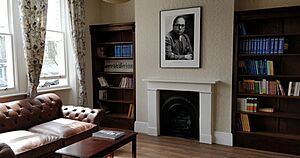
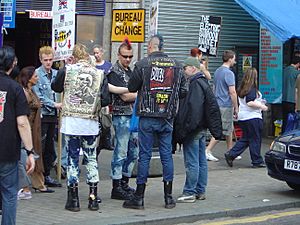
- The Roundhouse is a famous building that was originally built in 1847 to house train engines. Over the years, it was used for many things, like storing corn and gin. It was empty for a while until it became a theater, arts center, and music venue in 1966. It closed and then reopened in 2006 as a popular place for shows and concerts.
- Camden Catacombs are not real catacombs, but an underground area mostly beneath the Camden markets. They were once used as stables for horses and small ponies that moved railway wagons. They are not open to visitors because of the risk of flooding.
- St Pancras Old Church is a historic church in the area.
- The Camden Eye, at 2 Kentish Town Road, used to be called the Old Mother Red Cap. It was even used as a prison once!
- Greater London House, which used to be the Carreras Cigarette Factory, is now an office building. It's a striking Art Deco building from the 1920s, designed to look like an ancient Egyptian temple. It's famous for its two 8.5-foot-tall bronze statues of the Egyptian cat goddess Bastet.
- The Royal Veterinary College on Royal College Street was founded in 1791. It's the oldest and largest veterinary school in the UK.
- The Hawley Arms is a pub and music venue that became well-known in the 1990s. It was a favorite spot for singer Amy Winehouse, who was even rumored to serve drinks behind the bar!
Camden Highline
A new park and walkway is planned to use an old railway line between Camden Town and Kings Cross. It received permission to be built in January 2023.
Notable people
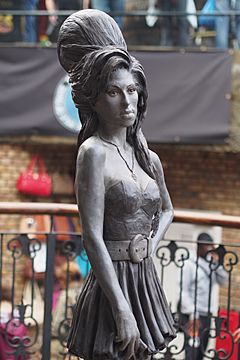
Many famous people have lived in or are connected to Camden Town:
- B. R. Ambedkar, a social reformer and lawyer, lived in Camden Town in the 1920s. His home is now known as Ambedkar House.
- Playwright Alan Bennett lived in Gloucester Crescent for many years.
- Author Charles Dickens lived in Camden Town in the 1820s. He even set parts of his famous stories, like A Christmas Carol and David Copperfield, in Camden.
- Actor and singer Anthony Head was born in Camden Town.
- Singer Amy Winehouse lived in Camden Town for many years and was strongly connected to the area. After she passed away, a bronze statue of her was placed in Stables Market.
- The hip-hop group N-Dubz grew up in the area.
- The famous music band Madness are from Camden Town and the surrounding areas.
- Actor Daniel Kaluuya grew up on a council estate in Camden Town.
- Singer Eliza Doolittle grew up here.
- Jazz Musician Nubya Garcia was born and grew up in Camden Town.
- Singer Dua Lipa grew up in Camden before moving to Kosovo.
Media
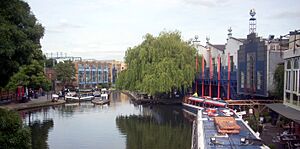
National
North of Camden Town station, along the canal, is a modern building designed by Terry Farrell. It used to be the studios for the TV show TV-am and is now used by MTV. You can still see TV-am's unique eggcup sculptures along the roof!
Local
The Camden New Journal is a free, independent weekly newspaper that covers news in the London Borough of Camden.
In popular culture
In literature
- Author Charles Dickens, who once lived in Camden Town, used the area in his stories. For example, Bob Cratchit's family in A Christmas Carol and the Micawbers in David Copperfield live there.
- E. Nesbit's 1904 children's novel The Phoenix and the Carpet is set in Camden Town.
- The climax of John le Carré's 1974 spy novel Tinker Tailor Soldier Spy happens in a safe house in Camden Town.
In film and television
- The 1986 comedy film Withnail and I is set in Camden Town in 1969.
- The 2008 film Happy-Go-Lucky mostly takes place in Camden Town.
- The 2015 film The Lady in the Van tells the true story of a homeless woman who lived in a van in Alan Bennett's driveway in Camden for 15 years.
- The 2015 documentary Amy, about Amy Winehouse's life, includes footage of her in Camden.
- The 2019 Disney animated series 101 Dalmatian Street is set in Camden Town.
- The TV series Peaky Blinders mentions Camden Town Gangs in its second season.
- The 2023 film Spider-Man: Across the Spider-Verse features the character Hobie Brown / Spider-Punk, who is from Camden Town.
In music
Many songs mention Camden Town:
- "You Just Can't Win" by Them (1965)
- "Camden Town" by Suggs (1995)
- "Come back to Camden" by Morrissey (2004)
- "Johnny Come Lately" by Steve Earle (1988)
- "Ladykillers" by Lush (1996)
- "Fame and Fortune" by The Libertines
- "How Did It Come to This" by Take That
- "So Close" by Matthew Good mentions Camden High Street.
- "Sorted for E's & Wizz" by Pulp mentions Camden Town.
- "One Better Day" by Madness refers to Arlington House, a hostel for the homeless in Camden Town.
- "London Boy" by Taylor Swift mentions her enjoyment of "walking Camden Market in the afternoon."
- "London Belongs To Me" by Saint Etienne (1991)
In games
- In Call of Duty: Modern Warfare (2019), a mission called "Clean House" is set in Camden Town.
Images for kids
See also
 In Spanish: Camden Town para niños
In Spanish: Camden Town para niños



